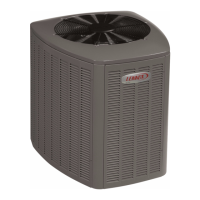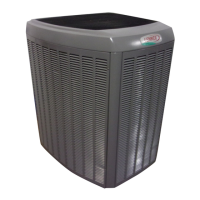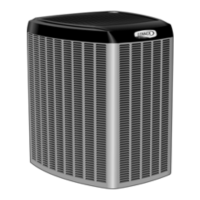Minimum Required Surface Area
for Disposable Filters
24,000 2.67
|
30,000 I 3.33
36,000
48,000
4.00
5.33
I
60,000 _ 6.67
Table 2
B149.2 (in Canada), should be followed. Piping must be of
adequate size to prevent undue pressure drop. Consult
the local utility or gas supplier for complete details on
special requirements for sizing gas piping.
The gas supply line should be routed through the grom-
met on the side of the unit. Refer to Figure 7 to locate this
access opening.
Gas and Electrical Access
Gas Line
Thermostat _C)
Entry
Line Voltage
Entry
Figure 7
If local codes allow the use of a flexible gas appliance
connector, always use a new listed connector. Do not use
a connector which has previously serviced another gas
appliance.
Pipe connections must be tight, and a non-hardening pipe
compound resistant to liquefied petroleum gases should
be used.
Install a manual shutoff valve in the gas connection to the
unit, external to the casing, in accordance with local
codes. An 1/8" NPT plugged tapping, accessible for test
gauge connection, must be installed immediately up-
stream of the gas supply connection to the unit. A sedi-
ment trap (drip leg) shall be installed as close as practical
to the gas supply inlet of the unit.
The furnace must be isolated from the gas supply piping
system by closing the individual manual shutoff valve
during any pressure testing of the gas supply piping
system at test pressure equal to or less than 1/2 psig
(3.5 kPa) or 14" W.C. If the piping system is to be tested at
pressures in excess of 1/2 psig (3.5 kPa), the furnace and
its appliance main gas valve must be disconnected from
the gas supply piping system.
After gas piping is complete, carefully check all piping
connections (factory and field) for gas leaks. Use a leak
detecting solution or other preferred means. Some soaps
used for leak detection are corrosive to certain metals.
Carefully rinse piping thoroughly after leak detection has
been completed.
LPG/Propane Units, Tanks, and Piping
Units are shipped equipped for natural gas, but can be
converted to LPG/propane in the field by an approved
licensed technician.
All LPG/propane gas equipment must conform to the safety
standards of the National Fire Protection Association.
# 48111B005 Page 7

